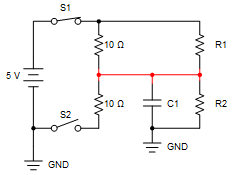FAQ: Logic and Voltage Translation > Input Parameters >> Current FAQ
The short answer is - a floating node is a voltage node that is not being forced to a known voltage, thus it has an unknown voltage.
Some additional details follow:
In circuit theory, a voltage node refers to a shared connection that is at the same voltage. To illustrate, I have developed a simple circuit:
The red highlighted node in the above circuit can be referred to as a voltage node. The voltage across C1 and R2 is equal.
For my circuit analysis below I make two assumptions:
(1) R1 and R2 are much larger than 10 ohms
(2) A very long time has passed, allowing C1 to reach a steady-state voltage
With the circuit configured as drawn, with S1 closed and S2 open, the voltage at C1 is ~5V.
If S1 were opened and S2 were closed, the voltage on C1 would be ~0 V.
In the event that both S1 and S2 are open, this is called a floating node. The voltage on C1 is unknown because we don't know the precise values of R1 and R2 (these represent parasitics on the board - paths for leakage current).
Because this is an ideal circuit, we could set values for R1 and R2, and then solve for the voltage on C1 and the node voltage would be constant. In the real world things aren't that simple.
But what if we add a few more factors into the circuit? Let's assume R1 and R2 are huge -- in this case, 10 Mohm each. Let's also add mutual inductance, an additional resistive leakage path, and some parasitic capacitance to nearby active traces:
In this case, nearby voltages can influence the voltage of C1. Rather than staying at exactly 1/2 Vcc (due to the voltage divider with 2x 10 Mohm resistors), the voltage on C1 will likely slowly vary up or down. This is why the voltage is said to 'float' -- it can be easily influenced by nearby signals and leakage currents.
In real systems, this can get far more complex, with added inputs from numerous sources both on and off the board. Let's suffice it to say if you are not actively forcing a node to a known voltage, then it is a floating node and the voltage is unknown.
Eliminating floating nodes is important in CMOS circuits to prevent problems. You can see more about this here:
[FAQ] How does a slow or floating input affect a CMOS device?



